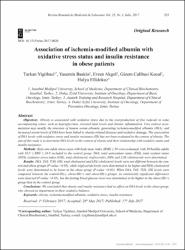| dc.contributor.author | Yiğitbaşı, Türkan | |
| dc.contributor.author | Baskın, Yasemin | |
| dc.contributor.author | Akgöl, Evren | |
| dc.contributor.author | Çalıbaşı Koçal, Gizem | |
| dc.contributor.author | Ellidokuz, Hülya | |
| dc.date.accessioned | 10.07.201910:49:13 | |
| dc.date.accessioned | 2019-07-10T20:02:53Z | |
| dc.date.available | 10.07.201910:49:13 | |
| dc.date.available | 2019-07-10T20:02:53Z | |
| dc.date.issued | 2017 | en_US |
| dc.identifier.citation | Yiğitbaşı, T., Baskın, Y., Akgöl, E., Çalıbaşı Koçal, G. ve Ellidokuz, H. (2017). Association of ischemia-modified albumin with oxidative stress status and insulin resistance in obese patients. Revista Romana de Medicina de Laborator, 25(3), 255-263. https://dx.doi.org/10.1515/rrlm-2017-0020 | en_US |
| dc.identifier.issn | 1841-6624 | |
| dc.identifier.issn | 2284-5623 | |
| dc.identifier.uri | https://dx.doi.org/10.1515/rrlm-2017-0020 | |
| dc.identifier.uri | https://hdl.handle.net/20.500.12511/3757 | |
| dc.description | WOS: 000407007100004 | en_US |
| dc.description.abstract | Objectives: Obesity is associated with oxidative stress due to the overproduction of free radicals in some accompanying states, such as hyperglycemia, elevated lipid levels and chronic inflammation. Free radical accumulation may modify the structure of human serum albumin, generating ischemia-modified albumin (IMA), and increased serum levels of IMA have been linked to obesity-related diseases and oxidative damage. The association of IMA levels with oxidative stress and insulin resistance (IR) has not been evaluated in the context of obesity. The aim of this study is to determine IMA levels in the context of obesity and their relationship with oxidative status and insulin resistance. Methods: Sixty-one adult obese cases with body mass index (BMI) = 30 were evaluated, with 30 healthy adults with 18.5 <= BMI <= 24.9 included in the control group. IMA, total antioxidant status (TAS), total oxidant status (TOS), oxidative stress index (OSI), total cholesterol, triglycerides, HDL and LDL-cholesterols were determined. Results: IMA, TAS, TOS, OSI, total cholesterol and LDL-cholesterol levels were not different between the control and obese groups (P-value >0.05), while triglyceride levels were determined to be higher and HDL-cholesterol levels were determined to be lower in the obese group (P-value <0.05). When IMA, TAS, TOS, OSI levels were compared between the control/IR(-), obese/IR(+) and obese/IR(-) groups, no statistically significant differences were detected (P-value >0.05), but the fasting blood glucose level was determined to be higher in the obese/IR(+) group than in the control group. Conclusions: We concluded that obesity and insulin resistance had no effect on IMA levels in the obese group, who showed no impairment in their oxidative balance. | en_US |
| dc.language.iso | eng | en_US |
| dc.publisher | University Press | en_US |
| dc.rights | info:eu-repo/semantics/openAccess | en_US |
| dc.subject | Obesity | en_US |
| dc.subject | Ischemia-Modified Albumin | en_US |
| dc.subject | Oxidative Stress | en_US |
| dc.subject | Insulin Resistance | en_US |
| dc.title | Association of ischemia-modified albumin with oxidative stress status and insulin resistance in obese patients | en_US |
| dc.type | article | en_US |
| dc.relation.ispartof | Revista Romana de Medicina de Laborator | en_US |
| dc.department | İstanbul Medipol Üniversitesi, Tıp Fakültesi, Temel Tıp Bilimleri Bölümü, Tıbbi Biyokimya Ana Bilim Dalı | en_US |
| dc.authorid | 0000-0002-0675-1839 | en_US |
| dc.identifier.volume | 25 | en_US |
| dc.identifier.issue | 3 | en_US |
| dc.identifier.startpage | 255 | en_US |
| dc.identifier.endpage | 263 | en_US |
| dc.relation.publicationcategory | Makale - Uluslararası Hakemli Dergi - Kurum Öğretim Elemanı | en_US |
| dc.identifier.doi | 10.1515/rrlm-2017-0020 | en_US |
| dc.identifier.wosquality | Q4 | en_US |
| dc.identifier.scopusquality | Q3 | en_US |


















